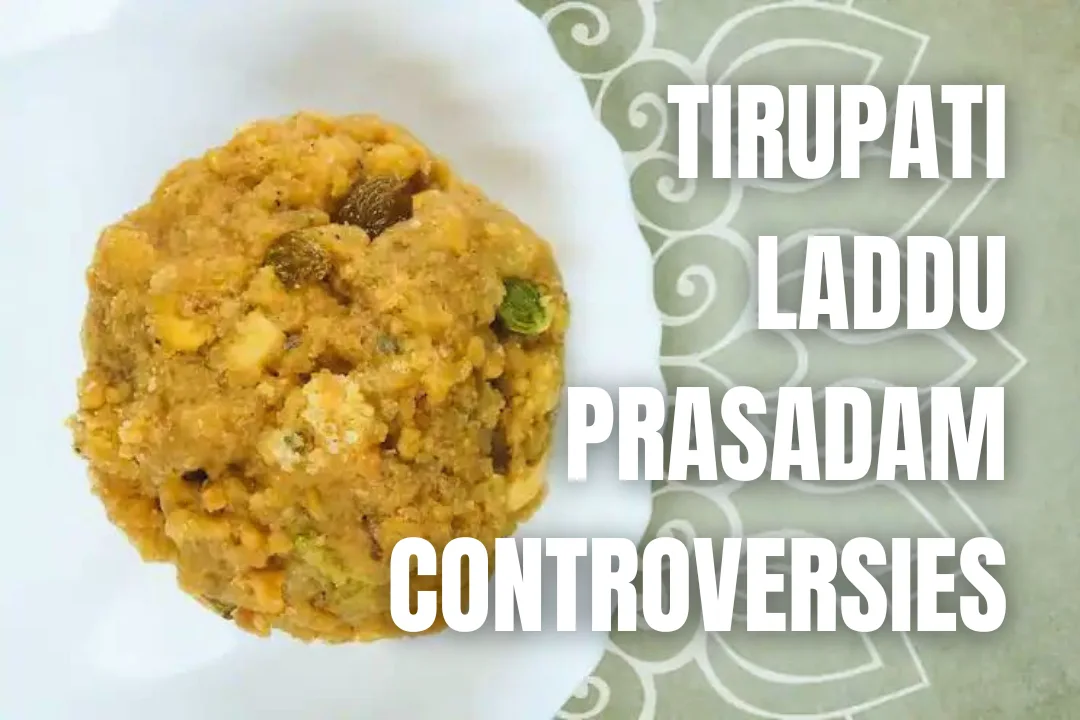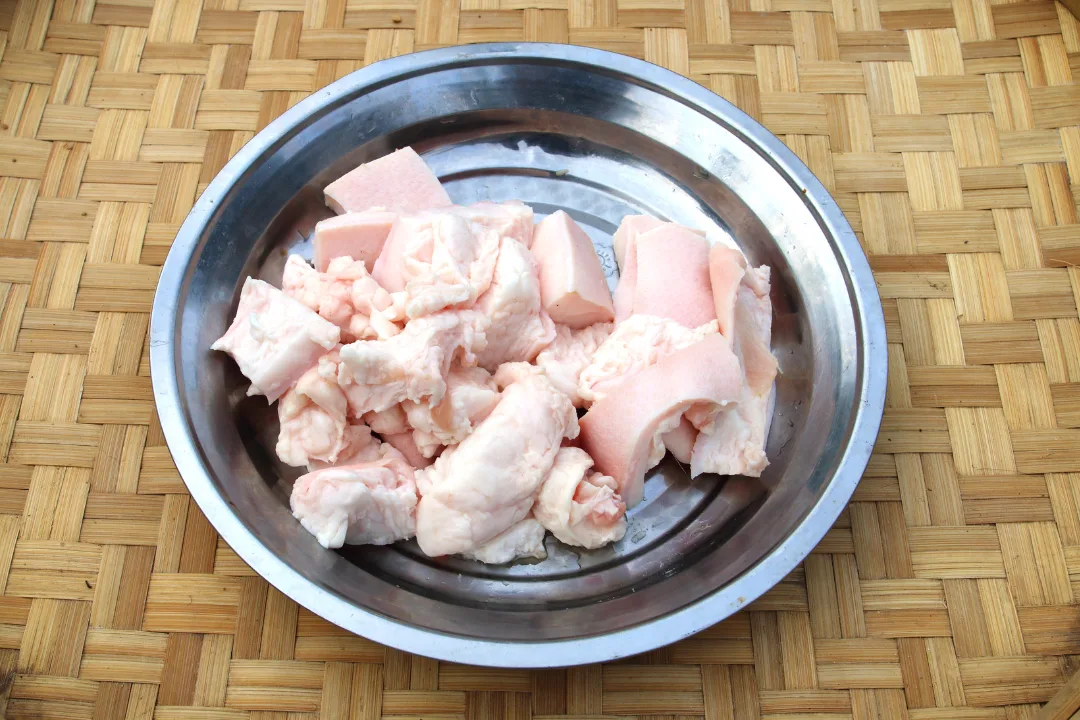Tirupati laddu Prasadam
A test report by a Gujarat-based laboratory has confirmed that beef fat, fish oil is used in making laddus in Tirupati temple and Fats were also found from plant sources such as coconut, flax-seed, rapeseed and cottonseed. There is a lot of uproar over the claim of animal fat being mixed in the offerings of Tirupati Balaji temple.
Andhra Chief Minister Chandrababu Naidu has alleged that the previous government had used animal fat instead of ghee in making the famous Tirupati Laddu Prasadam. This incident has spread anger among many devotees and they are demanding strict punishment to the culprits.
Food Safety Department raid Vizag Simhachalam temple after Tirupati Laddu Prasadam issue.The Food Safety Department seized 945 kg of ghee during the raid at Simhachalam temple and sent it to the laboratory for testing. Karnataka Milk Federation (KMF) said that TTD Board has not purchased ghee from them in the last 4 years. After NDA government came to power in Andhra Pradesh, KMF supplied Nandini Ghee.
A controversy has erupted over the alleged use of substandard ingredients and beef in the preparation of the world famous Tirupati Laddu. In July, lab tests revealed presence of foreign fats in ghee supplied by AR Dairy Foods, leading TTD to blacklist the contractor and switch to Karnataka Milk Federation. Earlier, TTD was paying Rs 320 per kg for ghee from AR Dairy Foods, but now procures it at Rs 475 per kg from Karnataka Milk Federation.
What is tallow?
Tallow is a substance made from fat extracted from cuts of beef such as rump roasts, ribs and steaks. Tallow can also be obtained by heating and melting the fat removed from meat.Turning it into a liquid that turns into a flexible, solid consistency when cooled to room temperature.
What is government doing regarding this matter?
At Tarupati Balaji temple Claims of animal fat being mixed in the prasad have caused a Significant uproar. meanwhile, CM charadrababu Naidu has ordered the Shanti Homam panchagavya prokshana a Cleansing Ceremony to be performed at the golden well yagyashala in Sri venkateswara temple. , one of the head priests, urged devotees to remain calm and encouraged them to visit temple for darshan. The political implications of the fat adulteration have intensified prompting the government to from a special investigation team (SIT) to prove the matter .
The SIT overseen by an inspector General or higher – ranking officer will thoroughly investigate the misuse of power and other Concerns. A report will be Submitted to the government Once investigation Concludes . CM Naidu has assured strict action to prevent future incidents of prasad adulteration . The petition filed in the Supreme Court has sought the appointment of a retired judge to oversee the management of the temples and an independent investigation. Party leader Pawan Kalyan, serving as the Deputy Chief Minister of Andhra Pradesh from June 2024, will be given ‘tapasya initiation’ for 11 days .
Is the Tirupati Temple under the government ?
Tarupati Balaji temple is not under the direct control of the Government of India . The Tirupati temple is owned and managed by the Tirumala Tirupati Devasthanams (TTD), an autonomous trust established by the state government . The administration of Tirupati temple is with the ‘Board of Trustees’ consisting of 7 members. The members of the Board of Trustees are appointed by the Government of Andhra Pradesh. TTD manages the daily operations, rituals and maintenance of the temple complex.
Tirupati’s GDP is US$3.48 billion. Tourism is the major industry in Tirupati. The entire economy directly or indirectly depends on TTD. 2 lakh to 10 lakh people visit Tirumala every day. Tirumala Tirupati Devasthanams (TTD) prepares and distributes around 3 lakh laddus daily at Tirumala. They earn around Rs 500 crore annually from the sale of laddus. Tirupati laddus considered ‘Maha Prasadam’ and carry high sentimental value.
There are three different types of laddus in Tirumala temple, after finishing the darshan and coming out of the temple everyone is given a small laddu weighing around 40 grams free of cost as prasad. The price of medium size laddu weighing 175 grams will be Rs 50/laddu and the price of large size laddu weighing 750 grams will be Rs 200/laddu. The state-of-the-art food testing research facility guarantees the nature of each clump of laddus. Each laddu should contain the right amount of cashew nuts, sugar and cardamom and weigh exactly 175 grams.
History of Tirupati Laddu
Sri Venkateswara Swami Temple is one of the world’s richest temples, situated in the hill town of Tirumala in the state of Andhra Pradesh. The temple is dedicated to Lord Sri Venkateswara, an incarnation of Vishnu.It is constructed in Dravidian architecture and is believed to be constructed over a period of time starting from 300 AD.
Additionally, the temple is located on the seventh peak of the Tirumala hills, symbolising the seven heads of Adisesha, the serpent god.It hosts Brahmotsavam, a nine-day event celebrated every year in September/ October. Furthermore, The tradition offering Laddus as prasadam at the Tirumala temple dates back to 1715. The kitchen where Tirupati laddus are made is known as Laddu Putu since ancient times. The magician behind the creation of the famous Tirupati Laddu is Kalyanam Iyengar, who introduced the popular Mirasidhari system of making the sweet.
In this, 3 different types of Laddus are made. Asthanam Laddus are made from saffron flowers, cashew nuts and almonds. Kalyanotsavam is prepared and distributed to the devotees of Kalyanotsavam. Proktham Laddus are common Laddus made and distributed among the pilgrims. Diṭṭam is the list of ingredients that are important in making delicious sweets which include flour, oil, sugar, ghee, dry fruits and cardamom. The recipe has been changed only six times in its history. Laddus received the Geographical Indication (GI) tag in 2009, it remains a symbol of devotion and faith for millions of pilgrims who visit the temple every year.
Also Read
WHY TIRUPATI BALAJI IS CONSIDERED AS RICHEST TEMPLE IN THE WORLD – THE HIDDEN TRUTH
To read more about these topics, visit our website, www.consumerviews.in and share it with your friends / Follow our Facebook page, Consumerviews India.











0 Comments